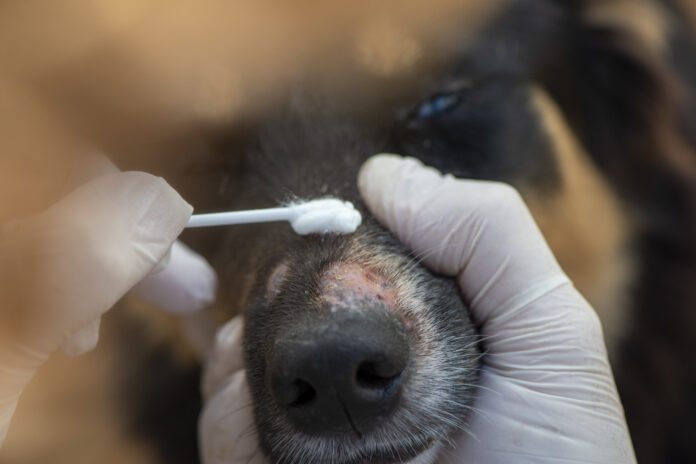Ringworm in dogs is a contagious fungal infection, including from dog to human. This is one of those instances where sharing is not caring! You can protect your dog from ringworm by keeping her away from dogs and other animals known or suspected to have ringworm.
Ringworm in Dogs
Dermatophytosis, commonly known as ringworm, is a fungal infection on the skin. It can be caused by several different fungi, but the most common is Microsporum canis. Despite the name, ringworm is not caused by worms. The name comes from the telltale shape of the skin infection, which is circular.
When a dog becomes infected with ringworm, she will develop patches of bald, scaly skin with broken hair. These patches can vary in size and shape, though the classic circular lesion looks like a ring. Some dogs will have bumps on the skin as well as having a dry, scaly appearance.
Most dogs with ringworm are not itchy. Affected dogs may have one lesion or several throughout the body. Occasionally, ringworm can infect the nails. This causes abnormal claws that are rougher in texture and brittle, leading to broken nails.
How Dogs Get Ringworm?
Dogs can get ringworm from other dogs or from humans or any other animal that has an active infection. If your dog brushes against another animal’s ringworm spot, they may become infected in turn.
Ringworm spores can also be present on furniture, bedding, or grooming tools that are used on an infected animal and then be spread to another dog that comes into contact with the contaminated item. Spores can remain in the environment for up to 18 months.
Puppies and immunocompromised dogs are at higher risk of contracting ringworm than healthy adult dogs.
How Do Indoor Dogs Get Ringworm?
Unfortunately, not every animal that has ringworm will show visible signs. Some are carriers who do not show infection themselves, but can pass the fungus to other animals. Even if your dog never goes outside or interacts with wildlife, she can still be exposed to ringworm through other pets or even through human family members.
How to Treat Ringworm in Dogs
Your veterinarian will check suspicious areas of your dog’s skin with an ultraviolet lamp that causes some strains of ringworm to glow. The veterinarian will also take a skin scrape and some hair samples to culture in a lab and see if fungal spores grow.
Once your dog has been diagnosed with ringworm, treatment will start. Treatment usually consists of both topical and systemic therapies, plus thorough cleaning of the home environment.
Your veterinarian will likely prescribe an antifungal ointment or shampoo that will help kill ringworm on the surface of the skin. Read the instructions on medicated shampoos carefully, as many of them are most effective if you let them soak into your dog’s skin and coat for several minutes.
Systemic therapy consists of oral antifungal pills. This helps to target any stubborn fungus that resists or is too deep to be affected by the topical treatment. Antifungals usually need to be taken for six weeks or more to fully clear the infection.
Stop Ringworm Spread
Vacuum all areas of your house where your dog spends time and wash all bedding. Dilute bleach can be used to kill the fungus. Regular and thorough cleaning will prevent other family members from becoming infected and prevent your dog from being reinfected.
Dogs can still be contagious for three weeks into treatment, so minimize contact with children and other animals and wash your hands thoroughly after touching your dog.
Your veterinarian will do at least two skin scrapes and cultures to monitor your dog’s progress and make sure the infection has cleared at the end of the treatment period.
Be Patient
Dealing with a ringworm infection isn’t fun, but with patience and persistence you can treat your dog’s infection and prevent anyone else in the house from getting it. Follow all treatment instructions, keep your infected dog separate from other pets, and clean frequently.





